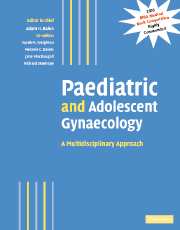Book contents
- Frontmatter
- Contents
- Contributors
- Preface
- Part I Normal development
- Part II Management of developmental abnormalities of the genital tract
- Part III Management of specific disorders
- 18 Disorders of growth and puberty
- 19 Turner's syndrome
- 20 Androgen insensitivity syndromes
- 21 Rokitansky syndrome and other Müllerian anomalies
- 22 The XY female
- 23 The gynaecology of the major genitourinary anomalies
- 24 Congenital adrenal hyperplasia
- 25 Long-term sequelae of genital surgery
- 26 Amenorrhoea
- 27 The polycystic ovary syndrome and adolescent women
- 28 Menstrual disorders in adolescent girls
- 29 Pelvic pain, ovarian cysts and endometriosis in adolescent girls
- 30 Premature ovarian failure and ovarian ageing
- 31 Gynaecological cancers in childhood
- 32 Late reproductive sequelae of treatment for childhood cancer
- 33 Preservation of fertility before cancer therapy
- 34 The management of infertility with surrogacy and egg donation
- 35 Dermatological conditions of the female genitalia
- 36 Vaginal discharge
- 37 Psychological gender development in individuals born with ambiguous genitalia
- 38 Eating disorders in adolescence
- 39 Nutritional amenorrhoea: long-term sequelae
- 40 How to set up a service: how to teach and train
- Index
- Plate section
- References
33 - Preservation of fertility before cancer therapy
from Part III - Management of specific disorders
Published online by Cambridge University Press: 04 May 2010
- Frontmatter
- Contents
- Contributors
- Preface
- Part I Normal development
- Part II Management of developmental abnormalities of the genital tract
- Part III Management of specific disorders
- 18 Disorders of growth and puberty
- 19 Turner's syndrome
- 20 Androgen insensitivity syndromes
- 21 Rokitansky syndrome and other Müllerian anomalies
- 22 The XY female
- 23 The gynaecology of the major genitourinary anomalies
- 24 Congenital adrenal hyperplasia
- 25 Long-term sequelae of genital surgery
- 26 Amenorrhoea
- 27 The polycystic ovary syndrome and adolescent women
- 28 Menstrual disorders in adolescent girls
- 29 Pelvic pain, ovarian cysts and endometriosis in adolescent girls
- 30 Premature ovarian failure and ovarian ageing
- 31 Gynaecological cancers in childhood
- 32 Late reproductive sequelae of treatment for childhood cancer
- 33 Preservation of fertility before cancer therapy
- 34 The management of infertility with surrogacy and egg donation
- 35 Dermatological conditions of the female genitalia
- 36 Vaginal discharge
- 37 Psychological gender development in individuals born with ambiguous genitalia
- 38 Eating disorders in adolescence
- 39 Nutritional amenorrhoea: long-term sequelae
- 40 How to set up a service: how to teach and train
- Index
- Plate section
- References
Summary
Introduction
In recent years, the improvement in the diagnosis, management and treatment of a range of solid and haematological childhood malignancies has led to a marked increase in the chances of long-term survival for a significant number of children and adolescents. However the chemo- and radiotherapies for treating cancers are frequently gonadotoxic and can render patients of either sex and any age temporarily or even permanently infertile. Like the malignant cells that are their intended targets, germ cells are highly susceptible to alkylating agents and platinum compounds used in chemotherapy formulations.
At the present time sperm banking remains the only proven method of fertility preservation for postpubertal boys, although hormonal manipulation and cryopreservation of testicular germ cells are possibilities for the future that could also benefit younger boys. The options for the preservation of female fertility are far more limited.
For girls and young women, mature oocyte freezing has many advantages, but it is unreliable. Most recently, the cryopreservation of immature oocytes in situ in small pieces of ovarian cortex followed by storage at low temperatures has been developed as an option to preserve female fertility before cancer treatment commences. Once the patient is in full remission and wishes to have fertility restored, the gonadal tissue can be thawed and either returned to the body as an autograft or, if there is any risk of reintroducing cancer cells in the graft, it may be possible to grow the gametes contained within the tissue to maturity in vitro.
- Type
- Chapter
- Information
- Paediatric and Adolescent GynaecologyA Multidisciplinary Approach, pp. 416 - 427Publisher: Cambridge University PressPrint publication year: 2004



